U prilogu koji slijedi, navedeni su „predmet i prvobitno obrazloženje“ teme koji su predstavljeni 6. aprila 2023. U međuvremenu je sadržaj detaljnije razrađen.
„Mladi i avangardni umjetnici su važan element kulturne scene u svakoj metropoli. Nebrojene izložbe, galerije, muzejske postavke, i manifestacije, pravi su magnet za stvaraoce, jer nude dosta mogućnosti za kreativni izraz. Ipak, život u svjetskim metropolama podrazumijeva i „ozbiljnu konkurenciju“, rijetke prilike za samostalna izlaganja, visoke cijene zakupa stambenog i galerijskog prostora, a nerijetko i teške uslove života. Toga su mnogi umjetnici svjesni, ali ipak biraju život u metropoli. Moja želja da upoznam svijet postojala je čini mi se oduvjek.
Život u inostranstvu mi je ispunjenje takve želje donekle olakšao. Studirao sam i radio u različitim metropolama od Amsterdama, Pariza, Berlina i Beča do Njujorka i Meksiko Sitija. Upoznao sam sjaj i bijedu ovih gradova i počeo da razmišljam o selidbi u neko „manje privlačno“ mjesto. Pitao sam se da li bi se tim potezom smanjio kvalitet mog umjetničkog rada? Da li bih tako ostao izolovan od svijeta umjetnosti? Izgubio kontakte? Ipak, donio sam odluku da se preselim u Bijeljinu, što sam i učinio 2016. godine. Pokazalo se da taj životni potez nije omeo moj umjetnički rad. Naprotiv. Oslobođen pritiska koji nose veliki gradovi, osjetio sam novu slobodu i još veći stvaralački impuls.
Odlučio sam da za svoje projekte ubuduće biram manja mjesta. Broj žitelja u malim mjestima se smanjuje, dobrim dijelom i zbog migracija stanovništva u veće gradove. Ono što manja mjesta na prvi pogled čini neprivlačnim, za mene je bilo izuzetno privlačno, a to je broj praznih objekata. Primjera radi, u gradovima istočne Njemačke kao što su Gerlic (Görlitz) i Cajc (Zeitz), ili kao što su Kozarska Dubica, Orašje, Bihać ili Foča, skoro polovina lokala, stovarišta i fabrika stoji neiskorištena.
U svojim master studijama, želio bih istražiti prazne prostore u Sarajevu, u njegovom centru, u predgrađu, ali i u okolnim selima. Ove prostore pokušao bih iskoristiti na nov način: kao mjesta za izložbe ili pop-up hepeninge. U planu je i izrada svojevrsne mape potencijalnih lokacija za kreativni sadržaj. Ukoliko se taj plan uspješno bude realizovao, ova mapa bi mogla biti od koristi i drugim umjetnicima, što bi potpomoglo stvaranje nove klime za umjetničke sadržaje u dužem trajanju. Ovaj projekat bi bio moj pokušaj da kroz mogućnosti koje imam kao dizajner, prikažem napuštene objekte iz drugačijeg i zanimljivijeg ugla, i kao takve ih približim dolazećim generacijama umjetnika, ma odakle da su.“
Sarajevo, 6. april 2023.
bašČARŠIJA/ SKENDERIJA
Baščaršija
Sa svojim uskim ulicama i raznobojnim dućanima, Sarajevska Čaršija predstavlja srce grada i mjesto bogate kulturne raznolikosti. Istorijski slojevita, preživjela je period Otomanskog carstva i kasnije promjene, što se ogleda u arhitekturi. Sa brojnim kafićima, restoranima i lokalnim radionicama, Sarajevska čaršija je mjesto gdje se prošlost i sadašnjost isprepliću. Međutim, danas mnogima nije poznato da je Čaršija prolazila kroz drastične promjene sredinom 20. vijeka koje su oblikovale današnji izgled.
Tokom vijekova, vrijeme je ostavljalo svoje tragove na Čaršiji. 1900-ih godina situacija nije bila idealna. Mnoge zgrade su zahtjevale renoviranje, higijenski uslovi i saobraćajna situacija su bili loši, što nije bilo povoljno ni za ljude ni za okolinu. Međutim, dok su se Austrijanci i prva Jugoslavija fokusirali na modernizaciju zapadno od starog jezgra prema Marijinom Dvoru, tek šezdesetih godina 20. vijeka gradska uprava ponovno je prepoznala istorijski značaj Čaršije. To je podstaklo razvoj prvih koncepata obnove.
Umjetnici, pisci, arhitekte i naučnici iz cijele države bili su uključeni kako bi odredili pravac djelovanja – od manjih izmjena do potpunih rušenja zgrada. Opširan plan restauracije je predstavljen 1971. godine, koji je predviđao drastične promjene. Potpuna obnova sanitarnih i eleltričnih instalacija, popločavanje, rušenje određenih zgrada, kako bi se napravilo mjesto za moderne novogradnje, kreiranje amfiteatra, precizno određivanje vizualnog identiteta prodavnica i još mnogo toga. Čak je razmatrana ideja o tunelu oko Vijećnice, radi potpunog oslobađanja trga oko Sebilja od saobraćaja. Dio ovih planova je sproveden 1975. godine. Ono što je zanimljivo je da je po prvi put izvršen sveobuhvatni popis radnji na Čaršiji, dajući tačne podatke o broju prodavnica i zanatlija.
Zanimljivo je vidjeti kako su se, pored tehničkih izmjena, već u to vrijeme razvijali koncepti za ambijent i cjelokupni vizuelni nastup. Takoreći kreiran je prvi brending Čaršije.

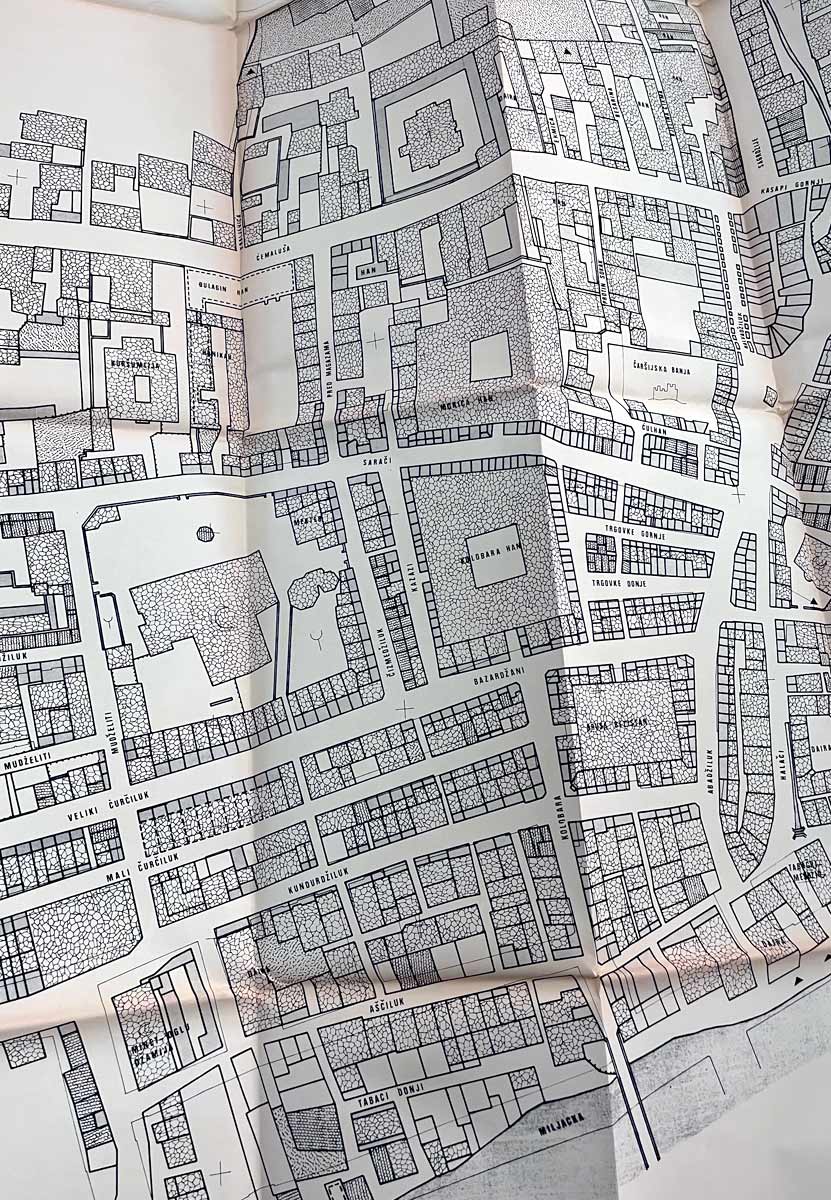
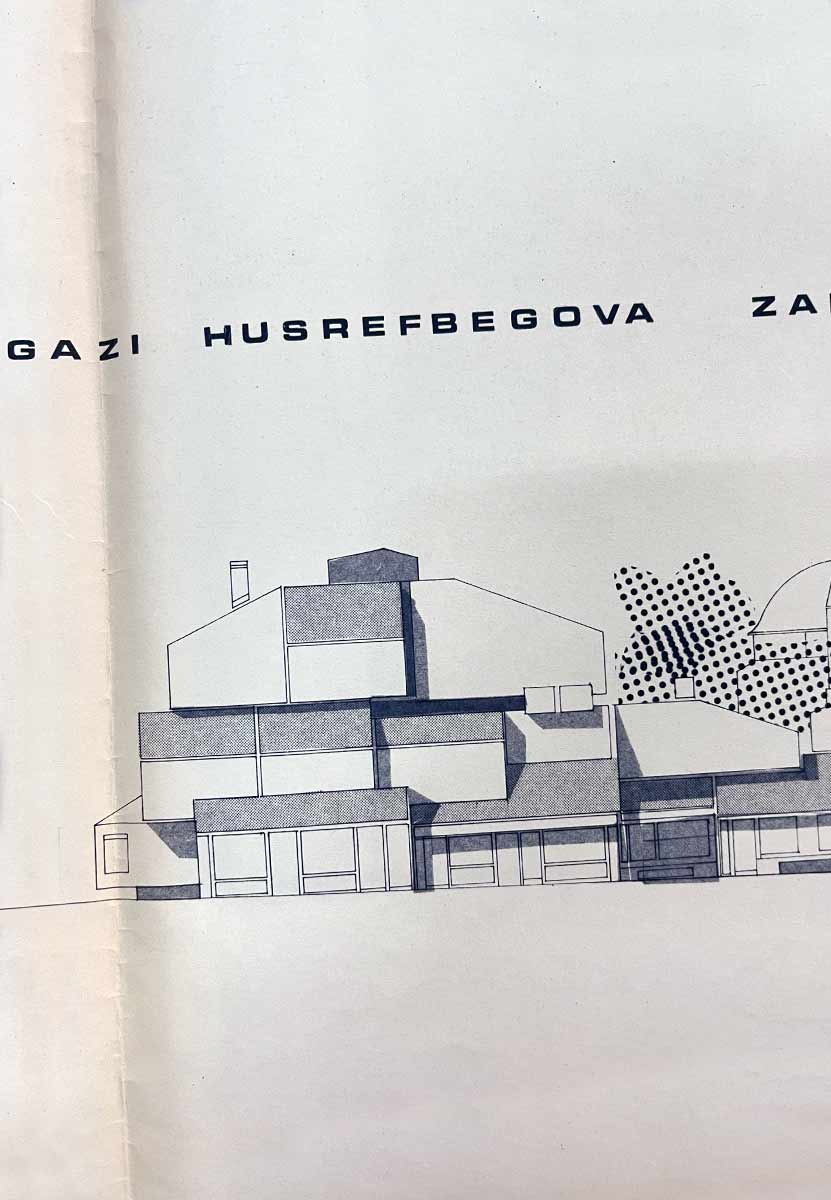
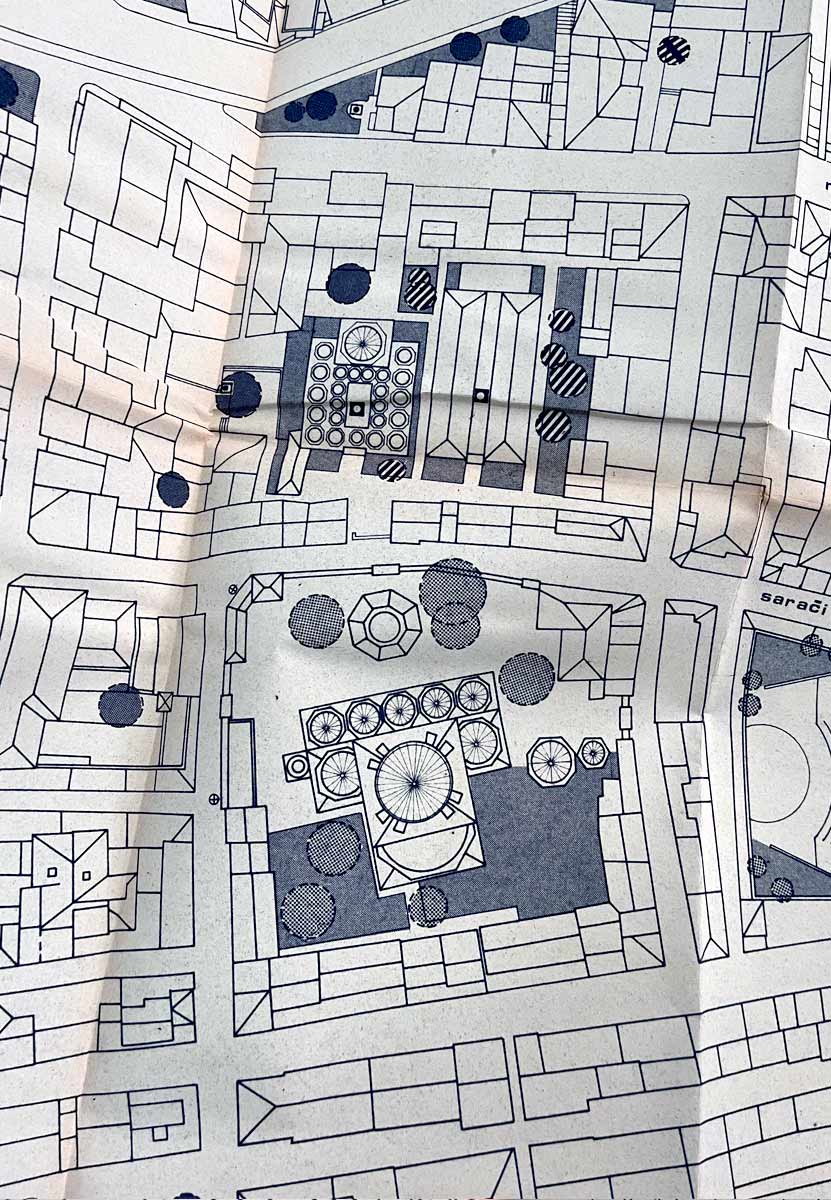
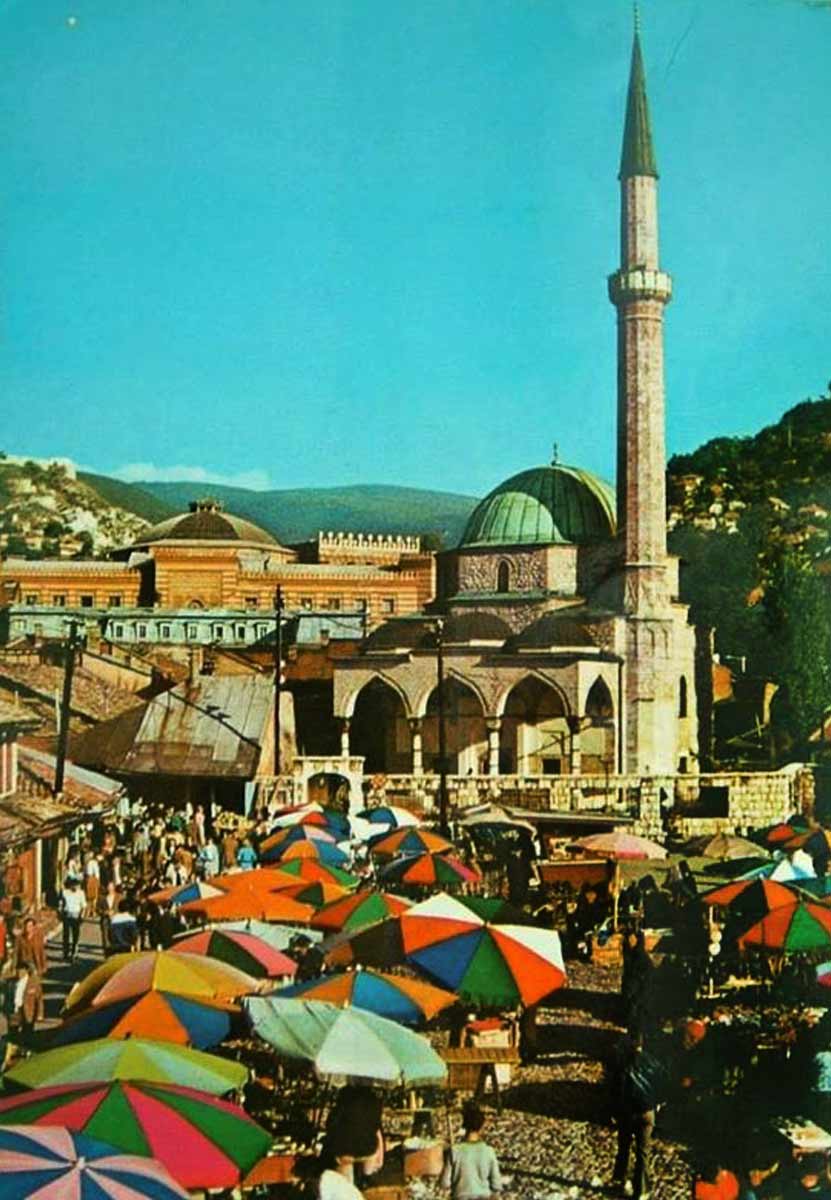
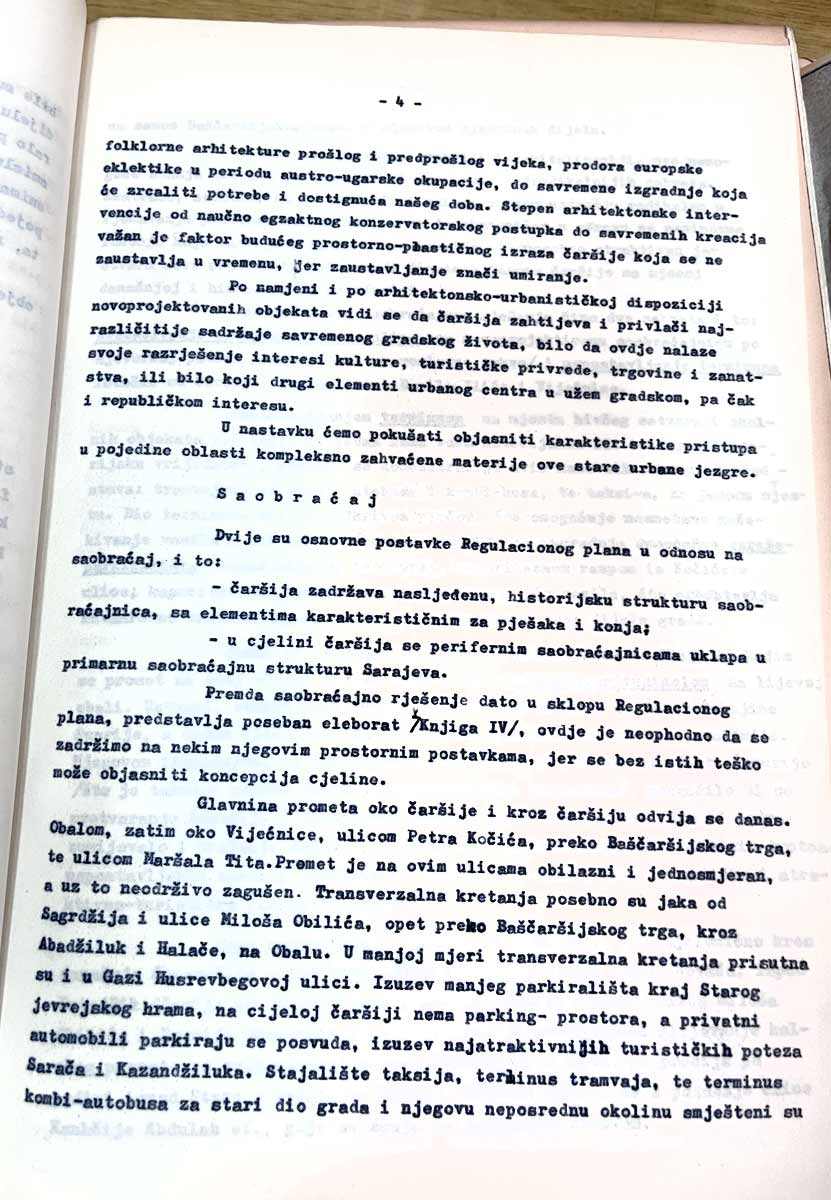
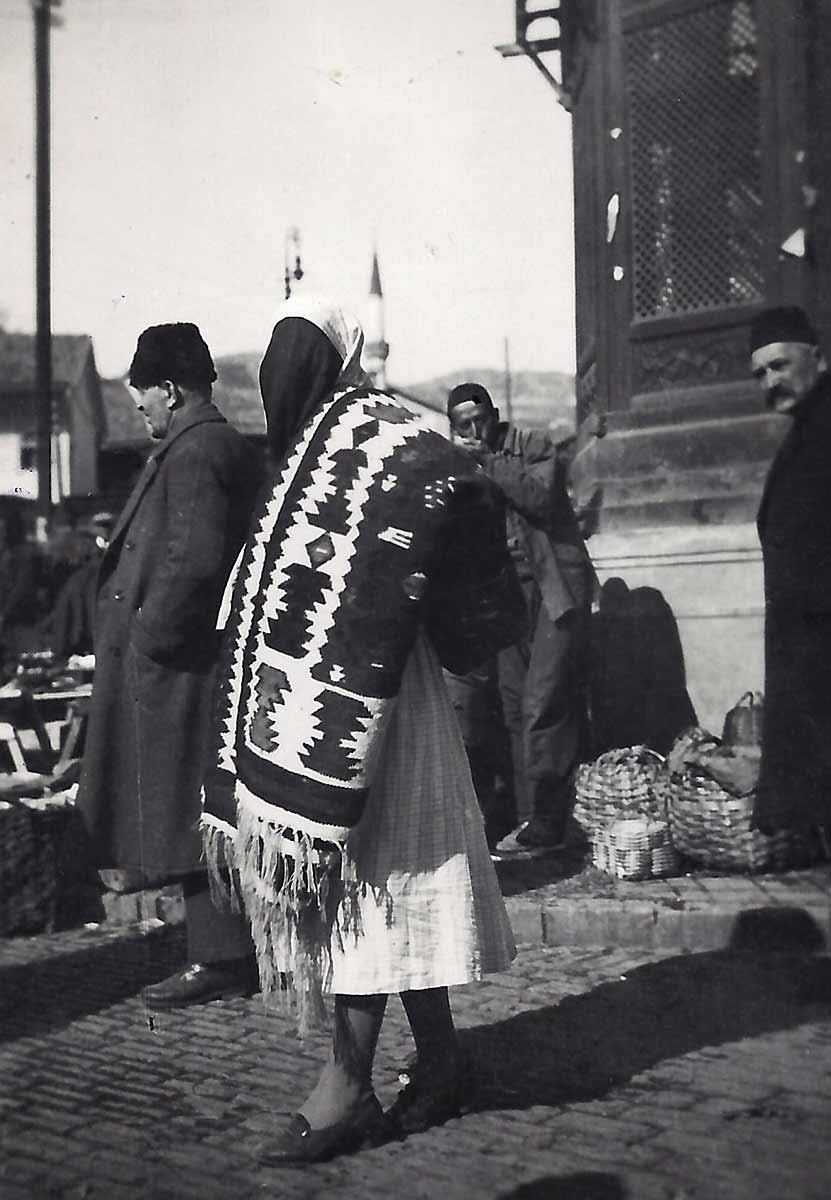
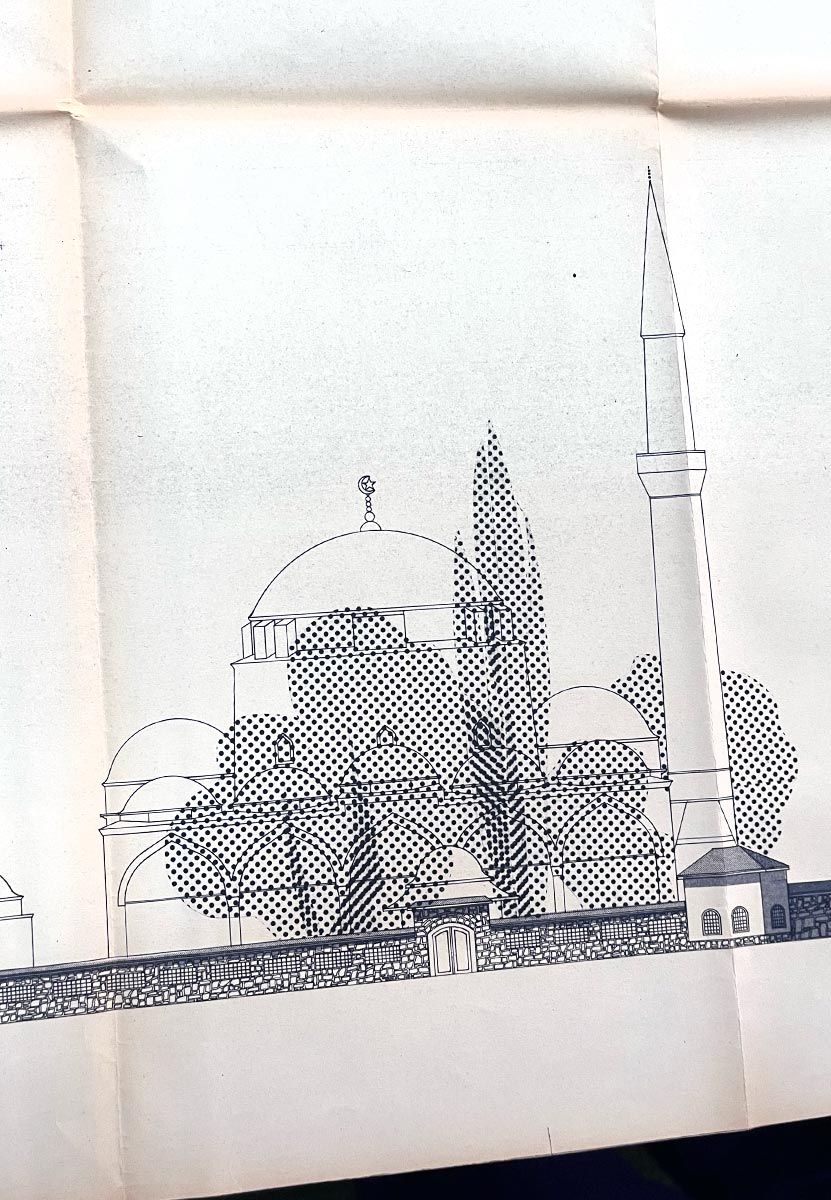
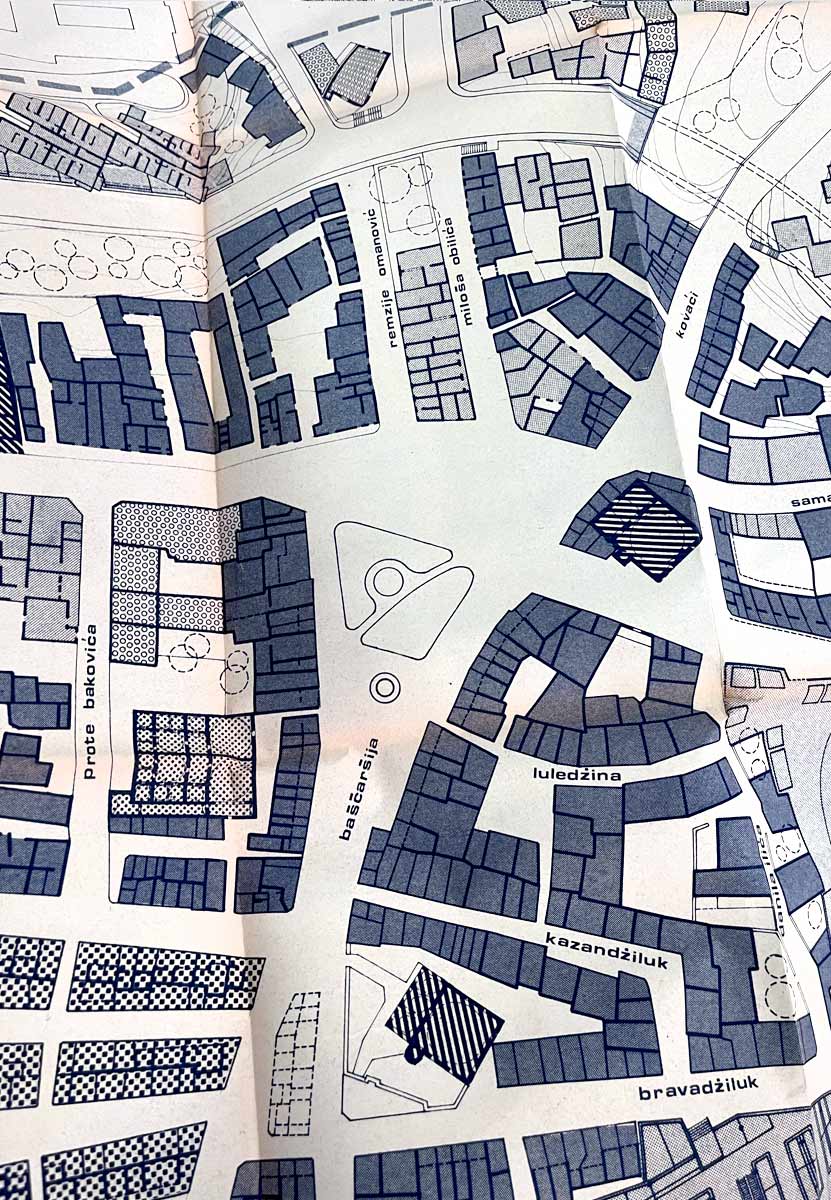



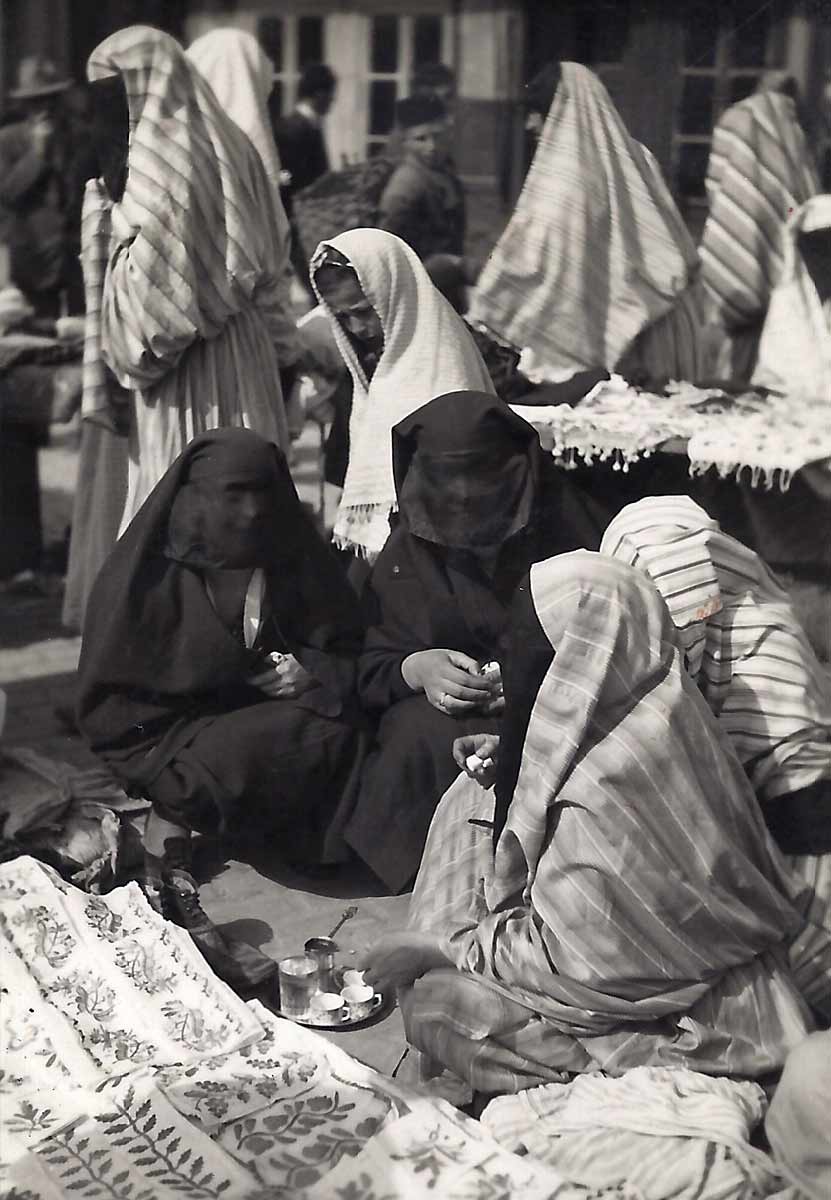
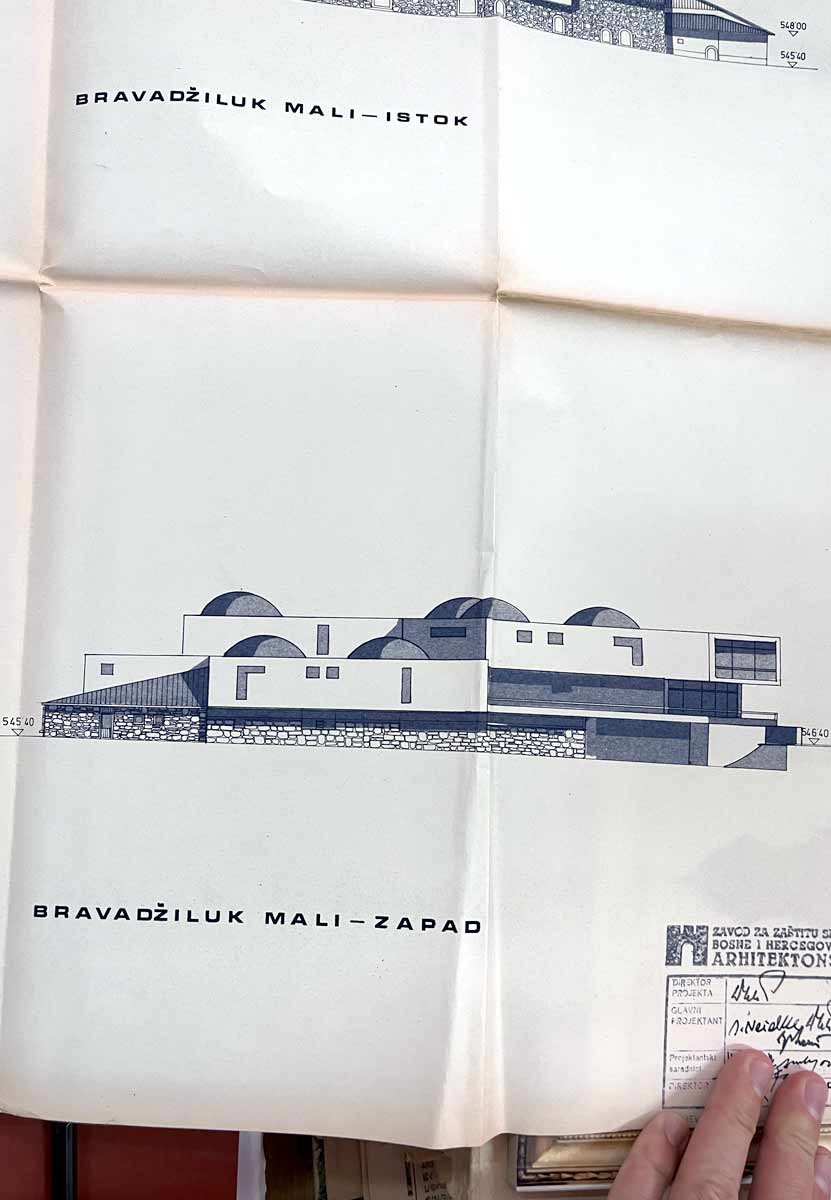
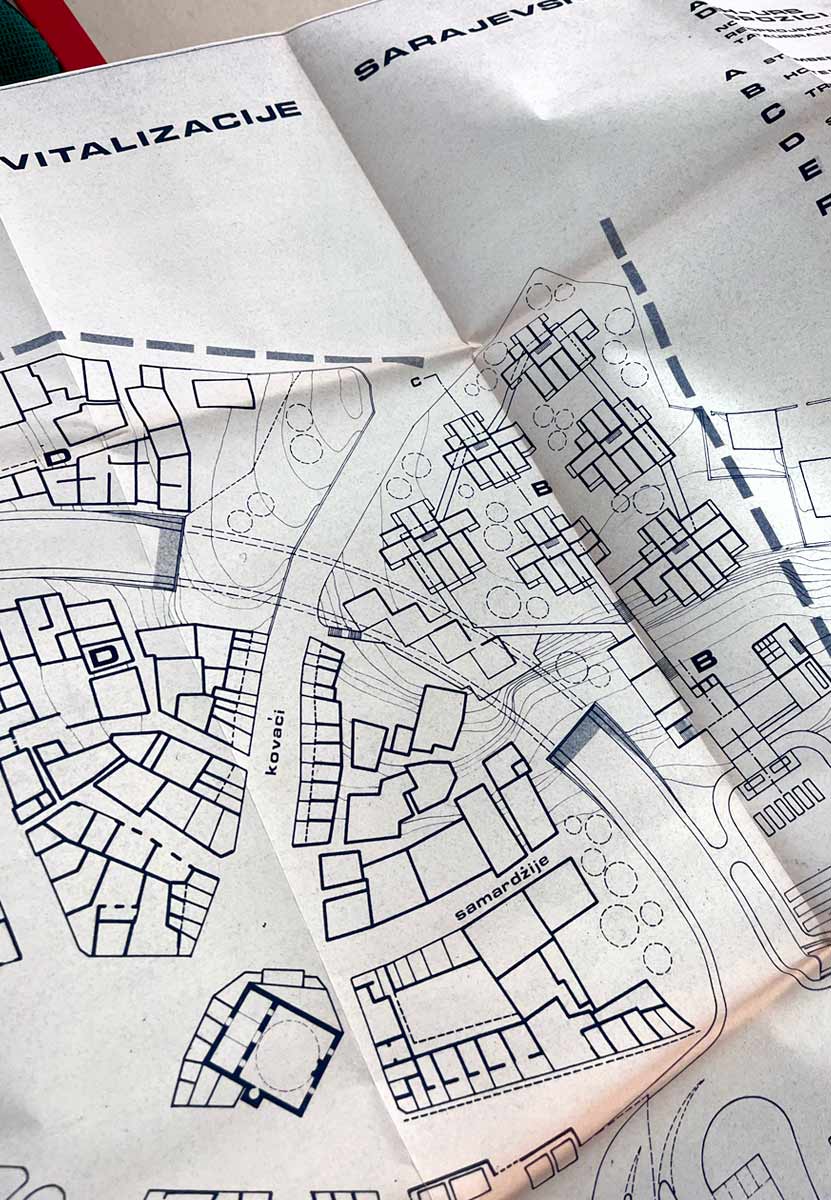
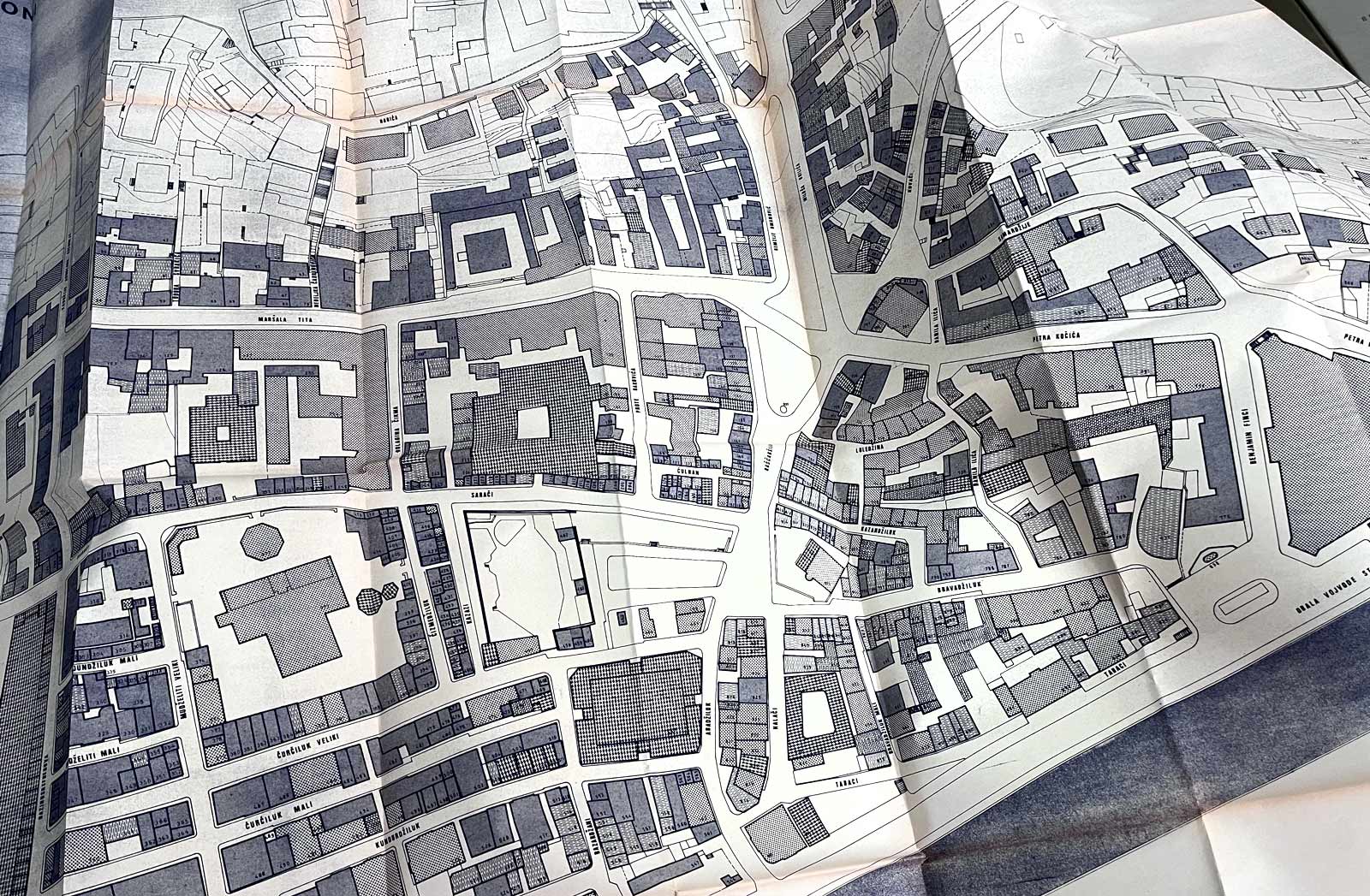

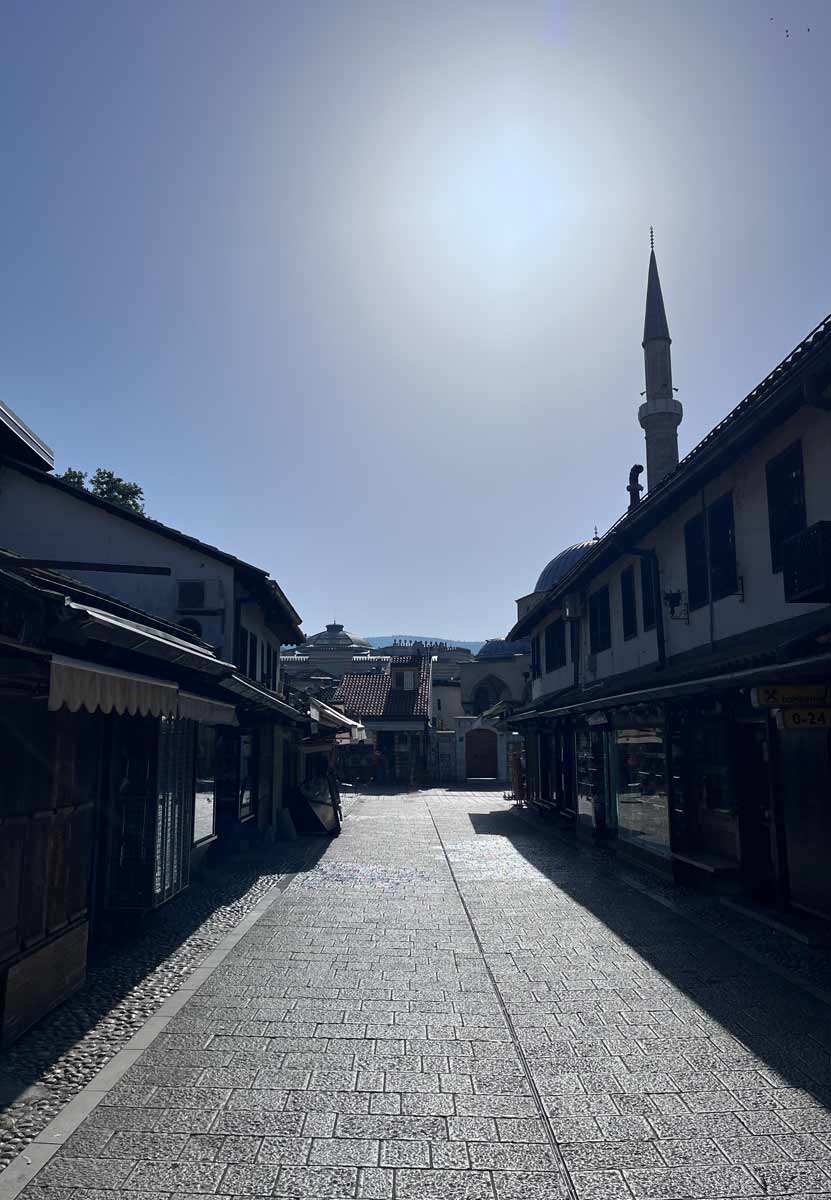
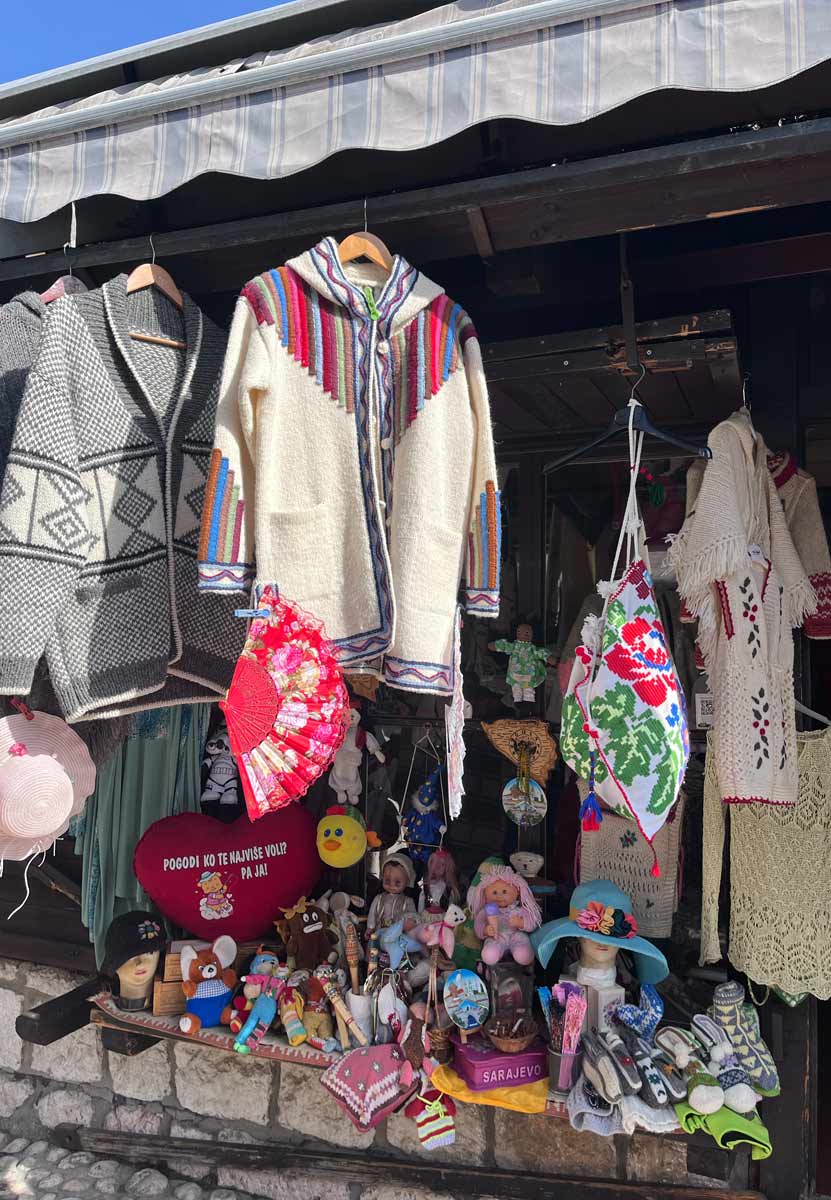
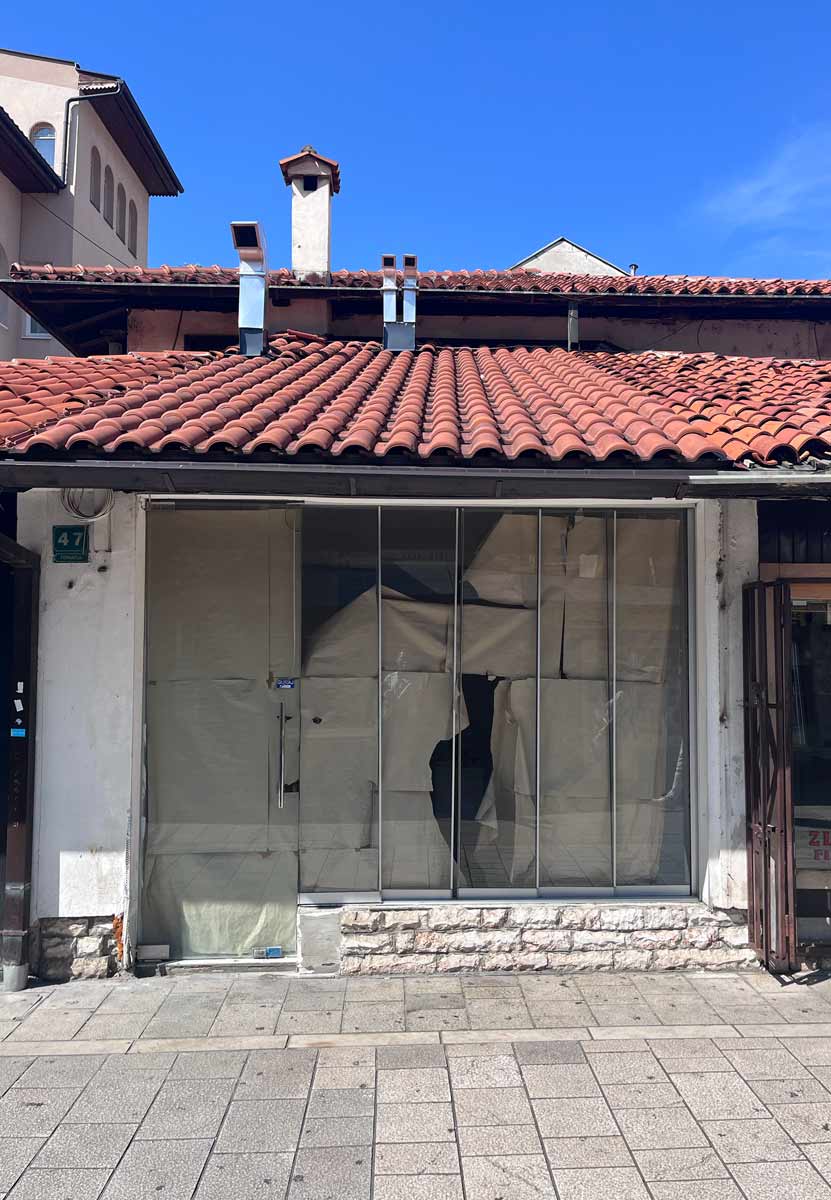

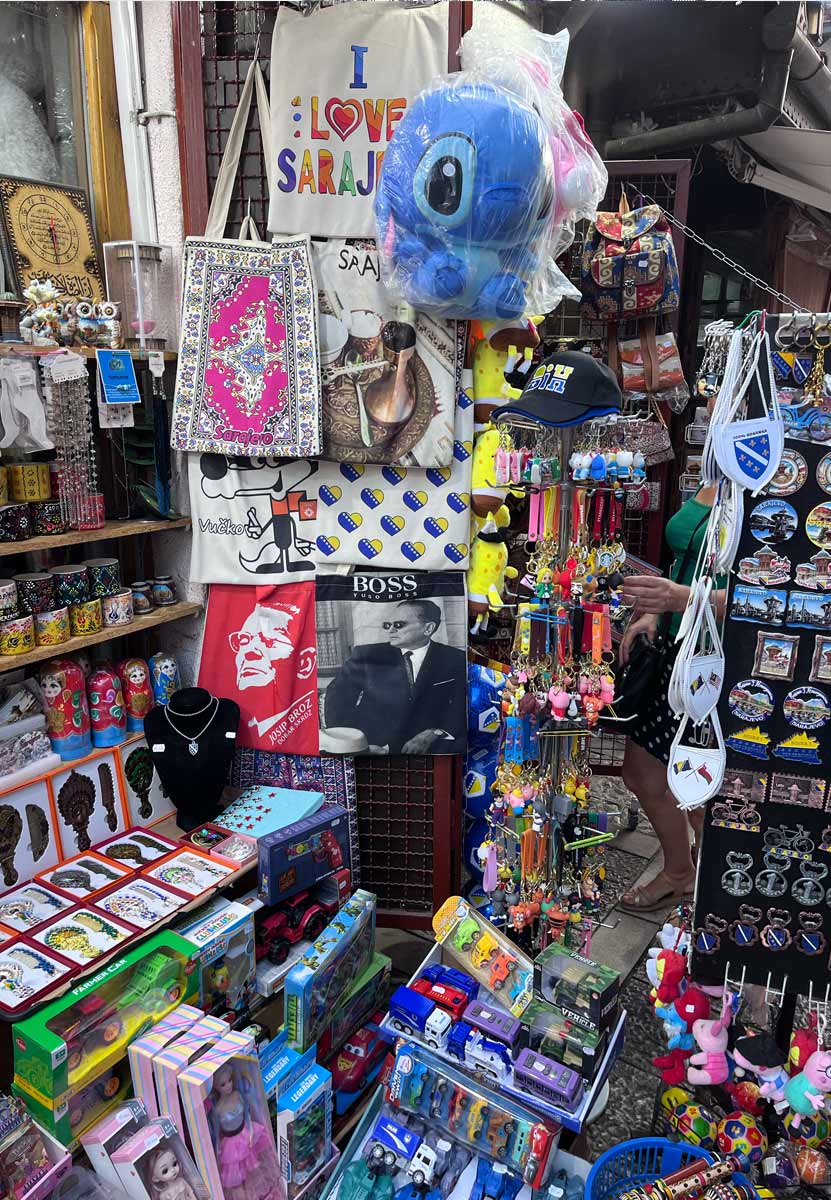

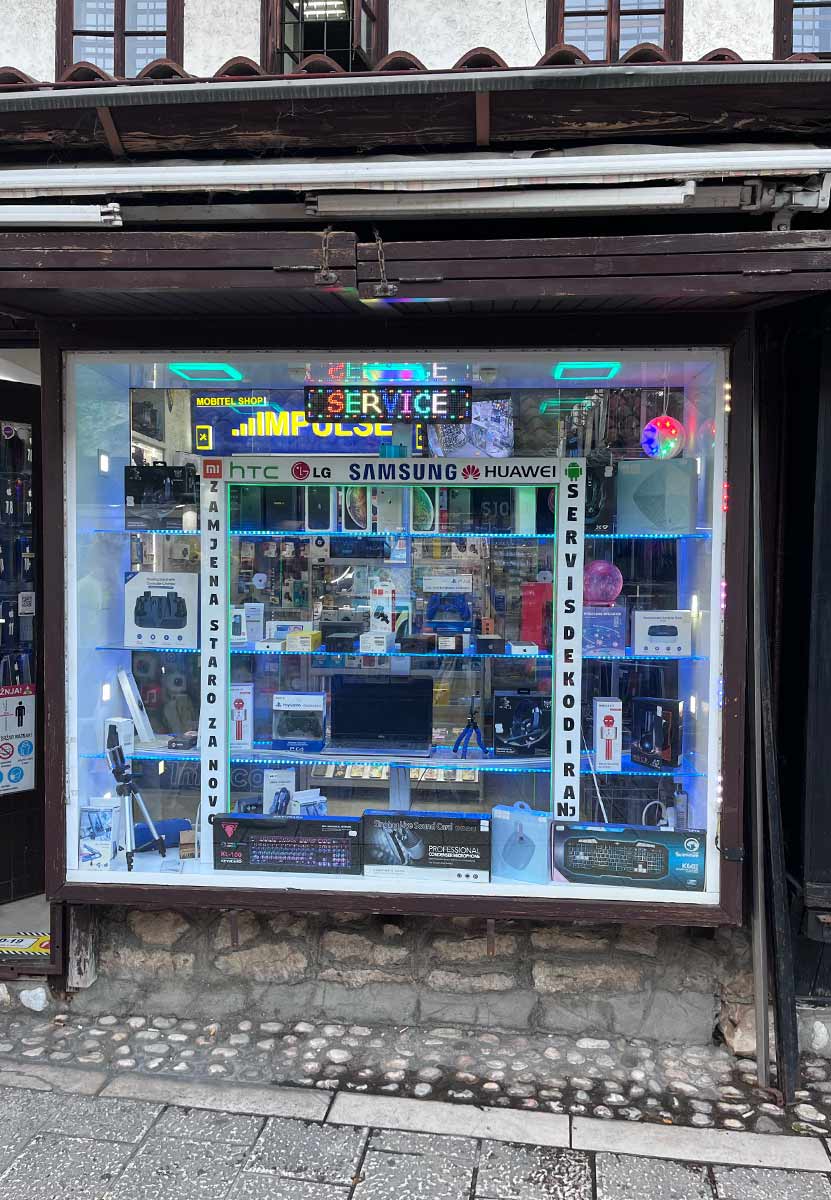
Skenderija 1969.–1984.–2023.
U isto vrijeme, u toku izrade master plana Čaršije, na suprotnoj strani grada nastao je još jedan kompleks zgrada koji će takođe kasnije dobiti istorijski značaj za grad. Riječ je o Skenderiji, raznovrsnom kompleksu sastavljenom od više pojedinačnih zgrada, namjenjenom sportskim i muzičkim događajima, trgovini i zabavi. Ovaj ansambl je stvoren u duhu modernizma šezdesetih godina i izdvaja se svojom brutalnom betonskom konstrukcijom sa izražajnom estetikom. Posebno zanimljivo za moj projekat je takozvani Privredni grad (više o tome tokom daljeg teksta), koji je izgrađen u podrumu. On suštinski predstavlja modernu interpretaciju Čaršije, sa malim prodavnicama duž različitih prolaza koje nude raznovrstan izbor proizvoda.
Na početku zamišljen kao privremeno ime za zgradu, naziv Skenderija je naišao na toliko pozitivan odjek prilikom predstavljanja da je na kraju ostao nepromjenjen.
Tokom Zimskih olimpijskih igara u februaru 1984. godine, Skenderija je putem nekoliko prepravki postala jedno od glavnih mjesta događanja. Na ovom mjestu je prvi put u Sarajevu zapaljen olimpijski plamen, održano je dodeljivanje medalja, ceremonije proglašenja pobjednika i održavani su timska takmičenja i konferencije za štampu. Iako nije toliko stara u poređenju s drugim zgradama u gradu, Skenderija svakako ima značajnu istorijsku vrijednost za Sarajevo.
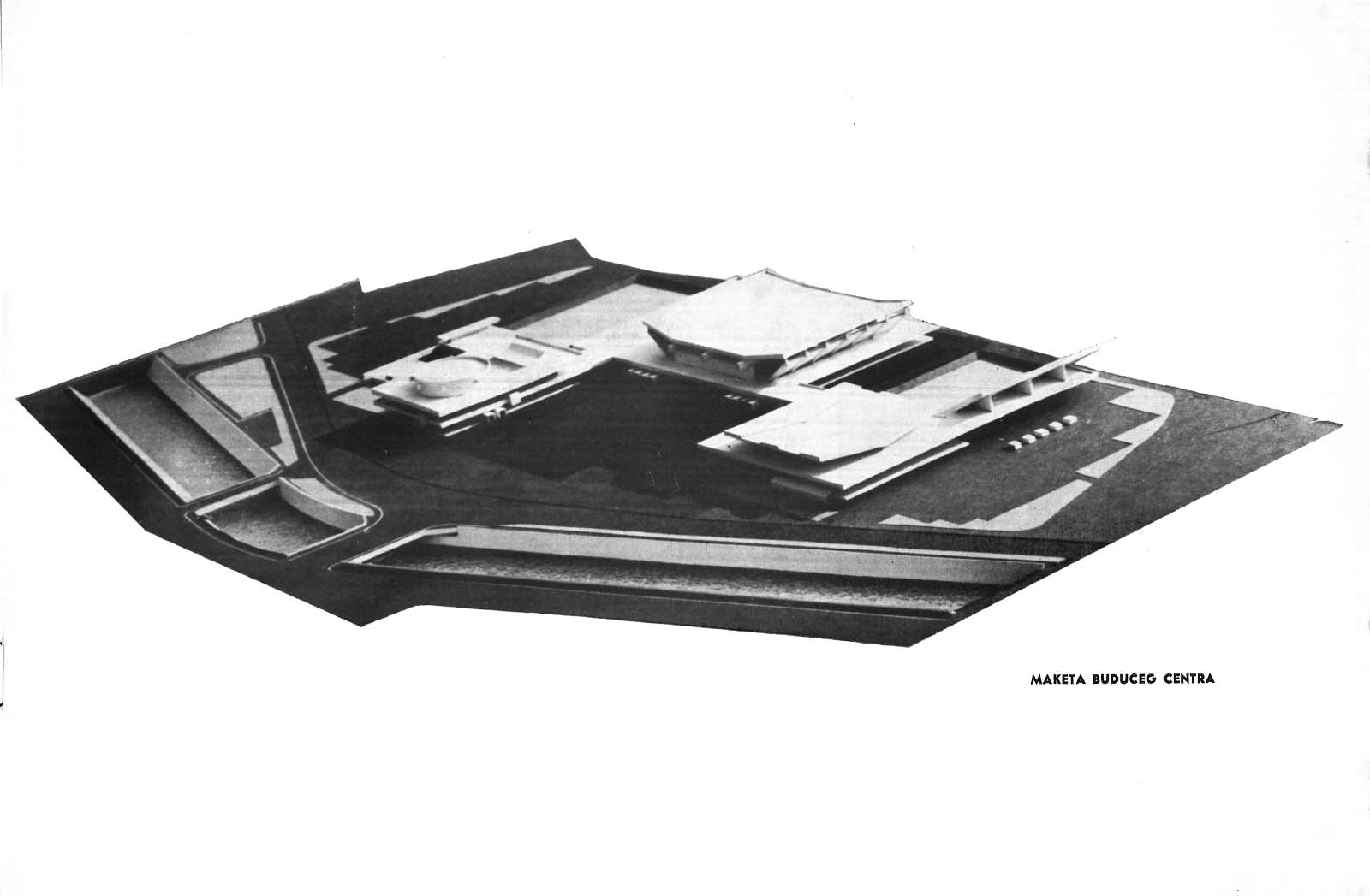
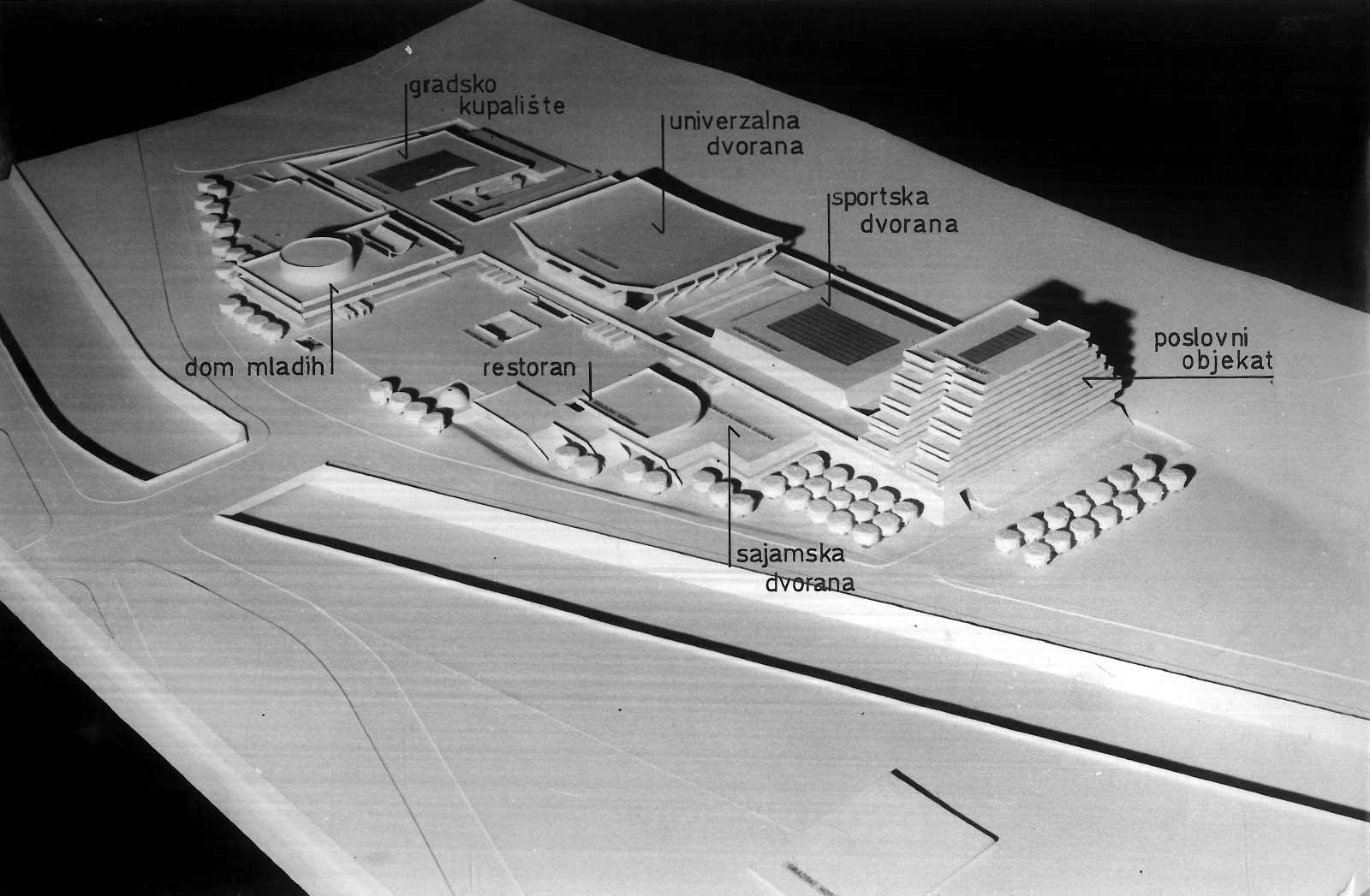

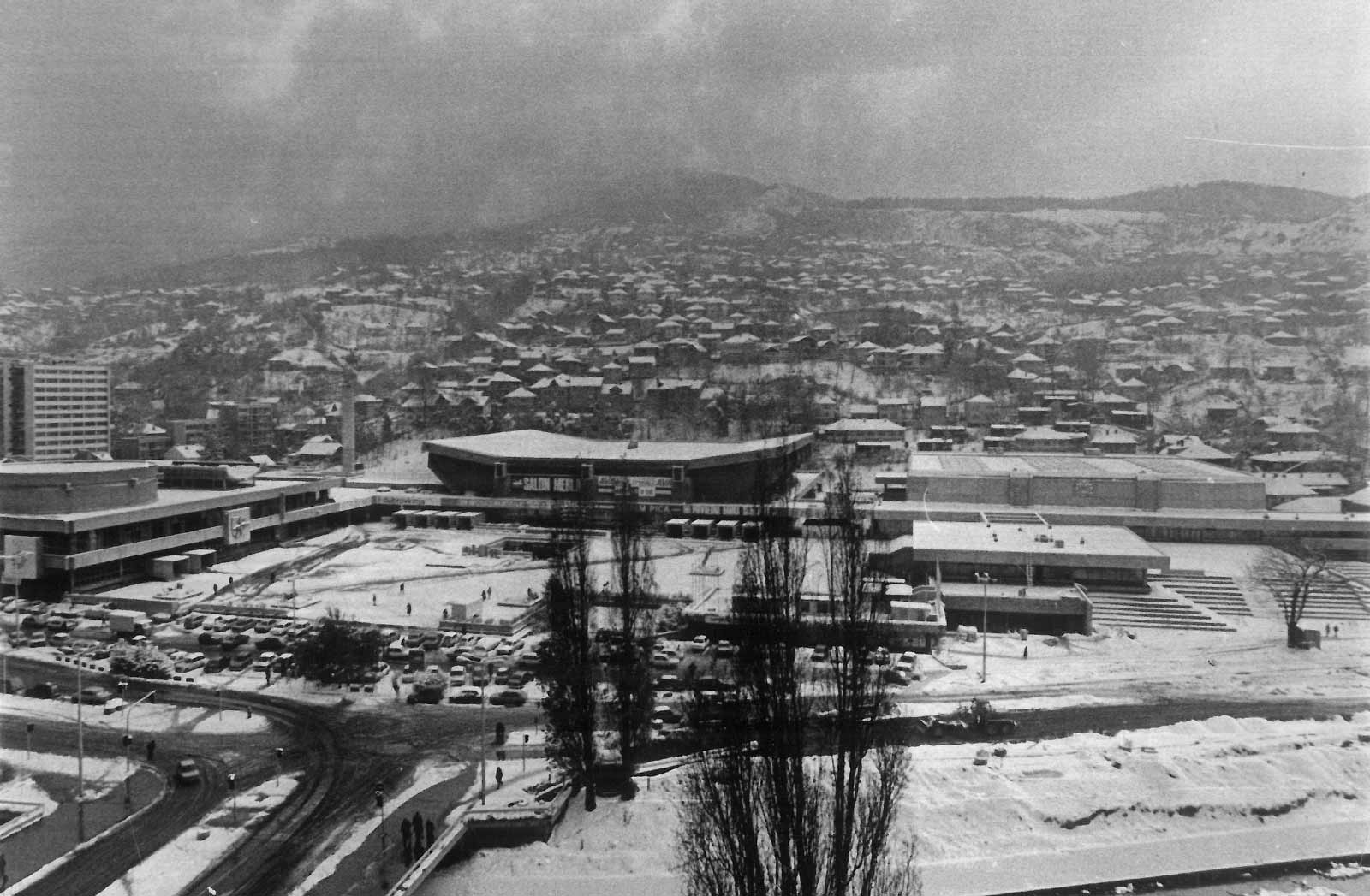


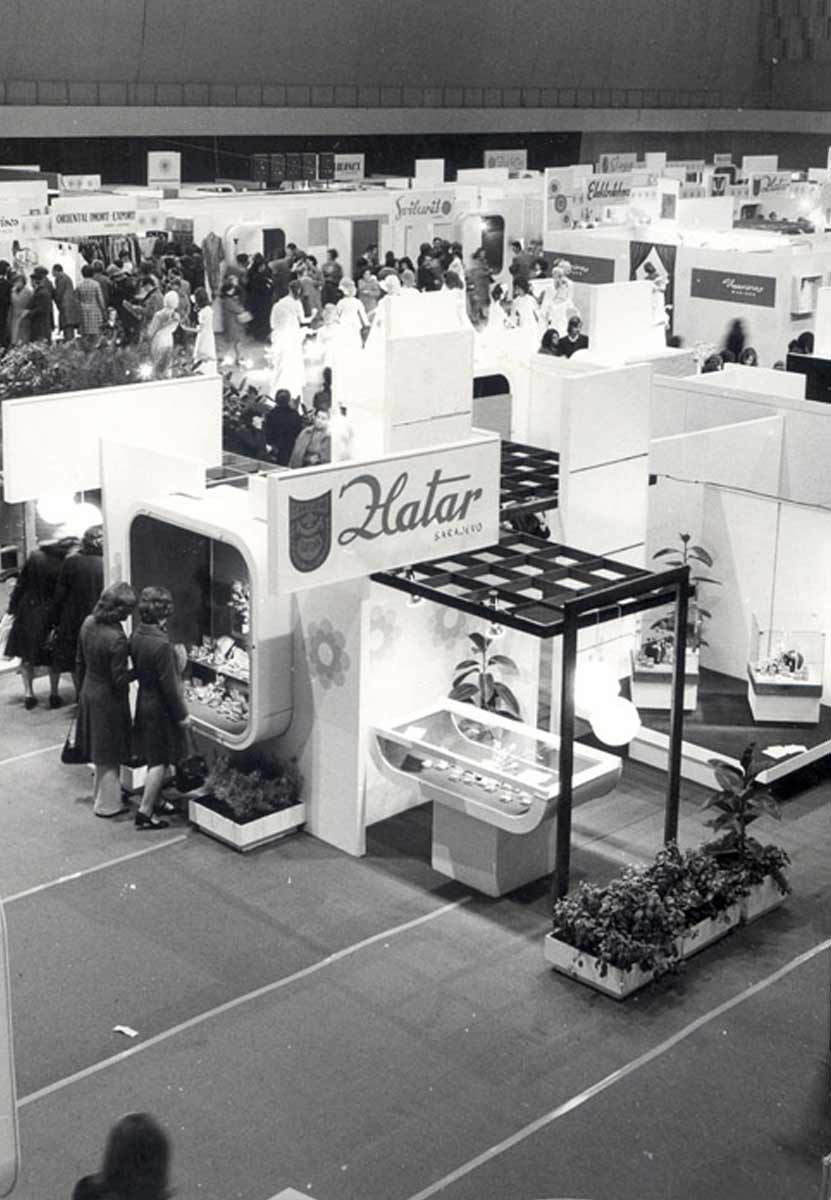



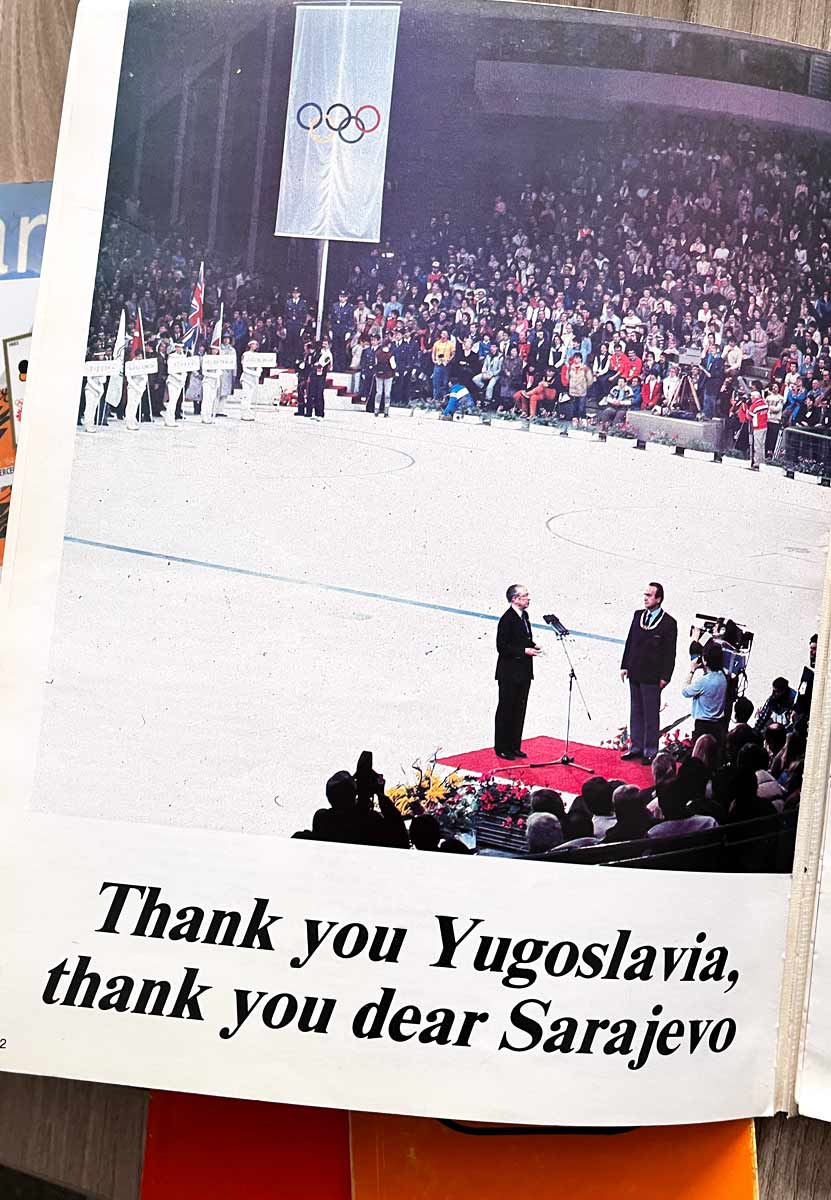
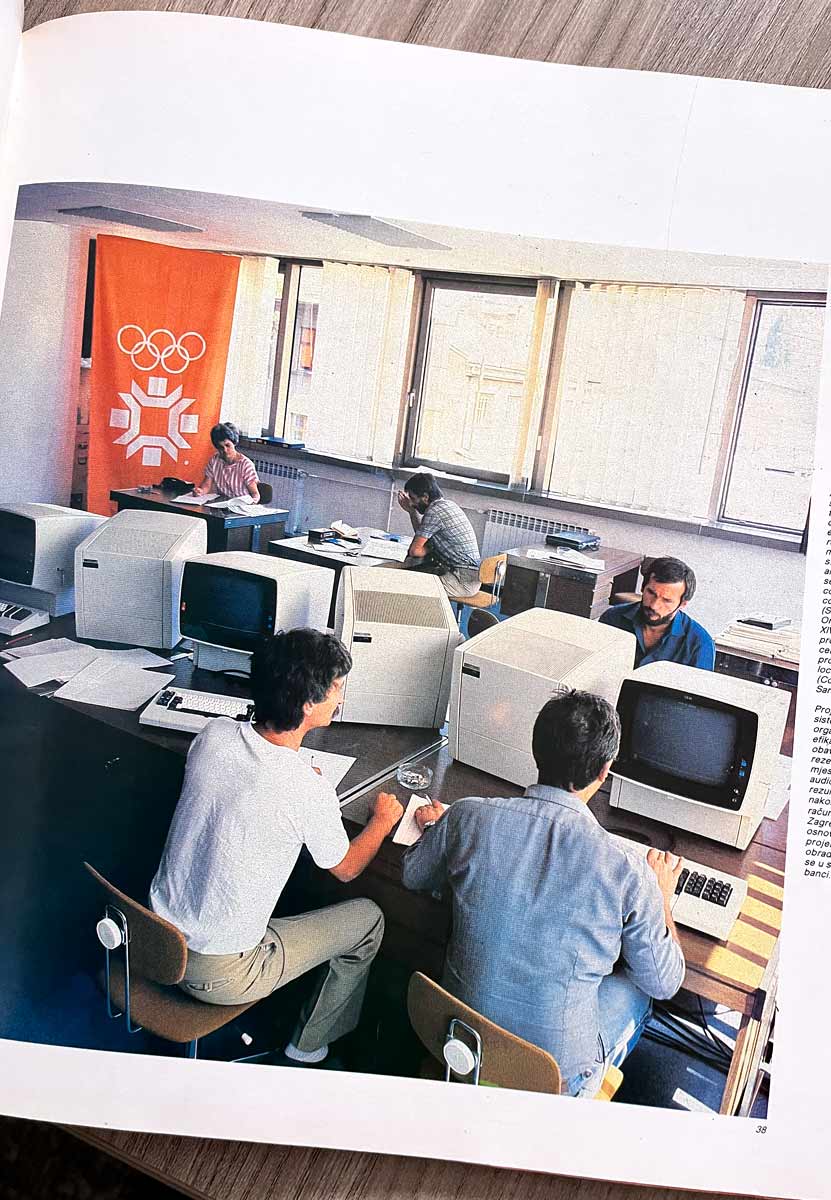
Trenutno stanje oba kompleksa
Trenutno stanje oba kompleksa je, u poređenju sa planiranim stanjem, suprotno očekivanjima. Baščaršija jeste zadržala svoju ekonomsku stabilnost kao turistička atrakcija, ali nedostaje efikasna kontrola, kao što je prvobitno planirano u urbanističkom planovima. Samovoljna redizajniranja dućana, često u upadljivo drečavim bojama, suprotstavljaju se nekadašnjim dizajnerskim smjernicama. To rezultira time da se scena pretvara u gomilu turističkog kiča. Bitna istorijska autentičnost Baščaršije sa svojim vješto izrađenim radnjama prijeti da bude ugrožena u narednim godinama, kako sugerišu i razgovori sa lokalnim zanatlijama.
Aktulena situacija sa Skenderijom takođe nije povoljna. Iako je zgrada skoro zaštićena kao spomenik kulture, muče je strukturalni problemi i značajno zapušteno stanje, što odvraća potencijalne trgovce i zakupnike poslovnih prostora. Većina lokala je prazna ili se koristi za jednostavne i jeftine namjene. Međutim, nedavna promjena uprave donosi planove da se zdanje jače istakne u javnosti i samoj svjesti stanovništva Sarajeva. Ova inicijativa ima za cilj da ponovo oživi privlačnost i interesovanje za Skanderiju i time ponovo otkrije njene potencijale.

Prema mojoj procjeni u ovom trenutku, smatram da je Skenderija odgovarajuće mjesto za moju pop-up prodavnicu. S jedne strane, vidim suštinsku ili istorijsku povezanost sa mojim tematskim namjerama. S druge strane, tehnički, administrativno i finansijski gledano, veoma je jednostavno privremeno iznajmiti prostor u takozvanom Privrednom gradu.
U prilogu koji slijedi, navedeni su „predmet i prvobitno obrazloženje“ teme koji su predstavljeni 6. aprila 2023. U međuvremenu je sadržaj detaljnije razrađen.
„Mladi i avangardni umjetnici su važan element kulturne scene u svakoj metropoli. Nebrojene izložbe, galerije, muzejske postavke, i manifestacije, pravi su magnet za stvaraoce, jer nude dosta mogućnosti za kreativni izraz. Ipak, život u svjetskim metropolama podrazumijeva i „ozbiljnu konkurenciju“, rijetke prilike za samostalna izlaganja, visoke cijene zakupa stambenog i galerijskog prostora, a nerijetko i teške uslove života. Toga su mnogi umjetnici svjesni, ali ipak biraju život u metropoli. Moja želja da upoznam svijet postojala je čini mi se oduvjek.
Život u inostranstvu mi je ispunjenje takve želje donekle olakšao. Studirao sam i radio u različitim metropolama od Amsterdama, Pariza, Berlina i Beča do Njujorka i Meksiko Sitija. Upoznao sam sjaj i bijedu ovih gradova i počeo da razmišljam o selidbi u neko „manje privlačno“ mjesto. Pitao sam se da li bi se tim potezom smanjio kvalitet mog umjetničkog rada? Da li bih tako ostao izolovan od svijeta umjetnosti? Izgubio kontakte? Ipak, donio sam odluku da se preselim u Bijeljinu, što sam i učinio 2016. godine. Pokazalo se da taj životni potez nije omeo moj umjetnički rad. Naprotiv. Oslobođen pritiska koji nose veliki gradovi, osjetio sam novu slobodu i još veći stvaralački impuls.
Odlučio sam da za svoje projekte ubuduće biram manja mjesta. Broj žitelja u malim mjestima se smanjuje, dobrim dijelom i zbog migracija stanovništva u veće gradove. Ono što manja mjesta na prvi pogled čini neprivlačnim, za mene je bilo izuzetno privlačno, a to je broj praznih objekata. Primjera radi, u gradovima istočne Njemačke kao što su Gerlic (Görlitz) i Cajc (Zeitz), ili kao što su Kozarska Dubica, Orašje, Bihać ili Foča, skoro polovina lokala, stovarišta i fabrika stoji neiskorištena.
U svojim master studijama, želio bih istražiti prazne prostore u Sarajevu, u njegovom centru, u predgrađu, ali i u okolnim selima. Ove prostore pokušao bih iskoristiti na nov način: kao mjesta za izložbe ili pop-up hepeninge. U planu je i izrada svojevrsne mape potencijalnih lokacija za kreativni sadržaj. Ukoliko se taj plan uspješno bude realizovao, ova mapa bi mogla biti od koristi i drugim umjetnicima, što bi potpomoglo stvaranje nove klime za umjetničke sadržaje u dužem trajanju. Ovaj projekat bi bio moj pokušaj da kroz mogućnosti koje imam kao dizajner, prikažem napuštene objekte iz drugačijeg i zanimljivijeg ugla, i kao takve ih približim dolazećim generacijama umjetnika, ma odakle da su.“
Sarajevo, 6. april 2023.
bašČARŠIJA/ SKENDERIJA
Baščaršija
Sa svojim uskim ulicama i raznobojnim dućanima, Sarajevska Čaršija predstavlja srce grada i mjesto bogate kulturne raznolikosti. Istorijski slojevita, preživjela je period Otomanskog carstva i kasnije promjene, što se ogleda u arhitekturi. Sa brojnim kafićima, restoranima i lokalnim radionicama, Sarajevska čaršija je mjesto gdje se prošlost i sadašnjost isprepliću. Međutim, danas mnogima nije poznato da je Čaršija prolazila kroz drastične promjene sredinom 20. vijeka koje su oblikovale današnji izgled.
Tokom vijekova, vrijeme je ostavljalo svoje tragove na Čaršiji. 1900-ih godina situacija nije bila idealna. Mnoge zgrade su zahtjevale renoviranje, higijenski uslovi i saobraćajna situacija su bili loši, što nije bilo povoljno ni za ljude ni za okolinu. Međutim, dok su se Austrijanci i prva Jugoslavija fokusirali na modernizaciju zapadno od starog jezgra prema Marijinom Dvoru, tek šezdesetih godina 20. vijeka gradska uprava ponovno je prepoznala istorijski značaj Čaršije. To je podstaklo razvoj prvih koncepata obnove.
Umjetnici, pisci, arhitekte i naučnici iz cijele države bili su uključeni kako bi odredili pravac djelovanja – od manjih izmjena do potpunih rušenja zgrada. Opširan plan restauracije je predstavljen 1971. godine, koji je predviđao drastične promjene. Potpuna obnova sanitarnih i eleltričnih instalacija, popločavanje, rušenje određenih zgrada, kako bi se napravilo mjesto za moderne novogradnje, kreiranje amfiteatra, precizno određivanje vizualnog identiteta prodavnica i još mnogo toga. Čak je razmatrana ideja o tunelu oko Vijećnice, radi potpunog oslobađanja trga oko Sebilja od saobraćaja. Dio ovih planova je sproveden 1975. godine. Ono što je zanimljivo je da je po prvi put izvršen sveobuhvatni popis radnji na Čaršiji, dajući tačne podatke o broju prodavnica i zanatlija.
Zanimljivo je vidjeti kako su se, pored tehničkih izmjena, već u to vrijeme razvijali koncepti za ambijent i cjelokupni vizuelni nastup. Takoreći kreiran je prvi brending Čaršije.
























Skenderija 1969.–1984.–2023.
U isto vrijeme, u toku izrade master plana Čaršije, na suprotnoj strani grada nastao je još jedan kompleks zgrada koji će takođe kasnije dobiti istorijski značaj za grad. Riječ je o Skenderiji, raznovrsnom kompleksu sastavljenom od više pojedinačnih zgrada, namjenjenom sportskim i muzičkim događajima, trgovini i zabavi. Ovaj ansambl je stvoren u duhu modernizma šezdesetih godina i izdvaja se svojom brutalnom betonskom konstrukcijom sa izražajnom estetikom. Posebno zanimljivo za moj projekat je takozvani Privredni grad (više o tome tokom daljeg teksta), koji je izgrađen u podrumu. On suštinski predstavlja modernu interpretaciju Čaršije, sa malim prodavnicama duž različitih prolaza koje nude raznovrstan izbor proizvoda.
Na početku zamišljen kao privremeno ime za zgradu, naziv Skenderija je naišao na toliko pozitivan odjek prilikom predstavljanja da je na kraju ostao nepromjenjen.
Tokom Zimskih olimpijskih igara u februaru 1984. godine, Skenderija je putem nekoliko prepravki postala jedno od glavnih mjesta događanja. Na ovom mjestu je prvi put u Sarajevu zapaljen olimpijski plamen, održano je dodeljivanje medalja, ceremonije proglašenja pobjednika i održavani su timska takmičenja i konferencije za štampu. Iako nije toliko stara u poređenju s drugim zgradama u gradu, Skenderija svakako ima značajnu istorijsku vrijednost za Sarajevo.












Trenutno stanje oba kompleksa
Trenutno stanje oba kompleksa je, u poređenju sa planiranim stanjem, suprotno očekivanjima. Baščaršija jeste zadržala svoju ekonomsku stabilnost kao turistička atrakcija, ali nedostaje efikasna kontrola, kao što je prvobitno planirano u urbanističkom planovima. Samovoljna redizajniranja dućana, često u upadljivo drečavim bojama, suprotstavljaju se nekadašnjim dizajnerskim smjernicama. To rezultira time da se scena pretvara u gomilu turističkog kiča. Bitna istorijska autentičnost Baščaršije sa svojim vješto izrađenim radnjama prijeti da bude ugrožena u narednim godinama, kako sugerišu i razgovori sa lokalnim zanatlijama.
Aktulena situacija sa Skenderijom takođe nije povoljna. Iako je zgrada skoro zaštićena kao spomenik kulture, muče je strukturalni problemi i značajno zapušteno stanje, što odvraća potencijalne trgovce i zakupnike poslovnih prostora. Većina lokala je prazna ili se koristi za jednostavne i jeftine namjene. Međutim, nedavna promjena uprave donosi planove da se zdanje jače istakne u javnosti i samoj svjesti stanovništva Sarajeva. Ova inicijativa ima za cilj da ponovo oživi privlačnost i interesovanje za Skanderiju i time ponovo otkrije njene potencijale.

Prema mojoj procjeni u ovom trenutku, smatram da je Skenderija odgovarajuće mjesto za moju pop-up prodavnicu. S jedne strane, vidim suštinsku ili istorijsku povezanost sa mojim tematskim namjerama. S druge strane, tehnički, administrativno i finansijski gledano, veoma je jednostavno privremeno iznajmiti prostor u takozvanom Privrednom gradu.